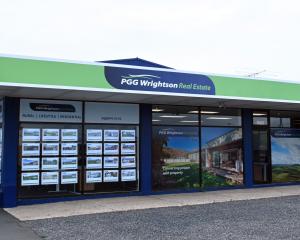Steve Fitzgerald surveys the land outside his home on Showgate Cres, in Mosgiel's Silver Springs subdivision. Photo by Allison Rudd.
Steve and Sharon Fitzgerald have not moved far.
It wasn't a difficult decision to make, Mr Fitzgerald said.
"We've always loved Mosgiel, but with our children growing up and leaving home our five-bedroomed family home in Goodall St was getting too big. And it seemed a good time to build here.
"Builders were offering good deals."
Their home sold quickly to another Mosgiel family.
The Fitzgeralds' house was one of the first built on Showgate Cres, in the Silver Springs subdivision, off Wingatui Rd.
The street is named after Show Gate, a championship galloper owned and trained by Gordon Thomson on the property, which has now become residential.
"His training track used to be about here," Mr Fitzgerald said, indicating the area from his immaculate lawn and vegetable garden to the roadway, houses and vacant sections beyond.
Since the Fitzgeralds moved in, another 20-30 houses had gone up around them.
Their neighbours were mostly couples in their 40s and older, some with young families, Mr Fitzgerald said.
He knew most had moved from other parts of Mosgiel or from Dunedin, with a smattering from wider Otago or even from Canterbury.
Around the corner in Didham Dr, named after another Mosgiel horse trainer, the late Arthur Didham sen, it is a similar story. Julie and John Forrester owned a house in Kenmure before being lured over the hill about 18 months ago.
"We always planned to move to Mosgiel one day, but it happened a little bit sooner that we expected. We saw a spec' house for sale and liked it," Mrs Forrester said.
Their Dunedin home sold in a week to a Dunedin couple buying it for their daughter.
"It was snapped up, which was good. We had three offers after the first open home."
Mrs Forrester said she and her husband were enjoying Mosgiel's peaceful rural aspect and friendly neighbours.
They had been surprised at the number of Dunedin people in Mosgiel: "We keep running into people we know when we are out walking. It is amazing who is here."
Mosgiel is the fastest-growing suburb of Dunedin, a trend fuelled by a landmark Environment Court decision in 2007 which rezoned 115ha of land from rural to residential.
In total, the land could be developed into 1400-1600 sections, increasing the number of households in Mosgiel by about 40%.
So far, more than 300 sections have been opened on the northwest edge of the town in the Wingatui Rd/Factory Rd/Hagart Alexander Dr area and the court ruling allows for hundreds more.
Another 100 or so sections are being built on in the Gladstone Oaks subdivision off Gladstone Rd North, with another 45 sold and ready to be built on in neighbouring HeathField subdivision.
The court also rezoned a large chunk of rural land at East Taieri, but that land has yet to be developed.
One of the largest subdivisions in Dunedin is Grandvista Estate in Abbotsford, where about 170 lots will eventually be developed.
More than 40 sections have been sold. Most already have occupied homes on them or homes under construction.
Real estate agent Jason Hynes, one of the LJ Hooker agents selling sections and land and home packages in the subdivision, said buyers had mainly been people from Dunedin.
Their existing homes had either been sold, or in some cases retained as a rental investment, he said. Some had been sold to first-home buyers who were a strong section of the Dunedin buyers' market.
There was not a flood of homes being sold by people wanting to build in subdivisions, he said.
"It's a gradual occurrence.
Not all their homes are on the market at the same time."
Dunedin seems well placed to absorb the present steady rate of new home construction totalling about 200 dwellings annually.
While Dunedin's population might appear static, it was actually growing, Dunedin City Council economic policy analyst Hamish Orbell said, and that trend was fuelling housing demand.
Last year's census was postponed because of the Christchurch earthquakes, but the estimate from Statistics New Zealand is that the city's population grew by 3700 between the 2006 census and last year.
It was estimated about 29% of that growth was through people moving to the city from overseas, with the remainder coming from migration from other parts of New Zealand and a natural increase in births over deaths, Mr Orbell said.
Statistics New Zealand estimated Dunedin might need 7700 more households by 2021 to cater for population growth and changing household needs.
Household units are getting smaller, with more dwellings lived in by just one or two people.
Conversely, people these days wanted bigger houses.
In the city's Residential 1 zone, where almost 80% of homes are situated, the average floor area of homes is expanding. The average floor area for homes built in the 1950s was 120sqm; by 2009 that had almost doubled.
As well as their size, homes in new subdivisions had other attractive features, in particular sunshine and insulation, and, in the case of Mosgiel - flat sections.
The relatively sudden increase in new housing in Mosgiel had led to extra expenses for the council, Mr Orbell said. Costs had been incurred to provide infrastructure improvements to water and sewage treatment pipes and pumps.
However, the cost was eventually fully recovered through development contributions paid by the subdivision developers.












